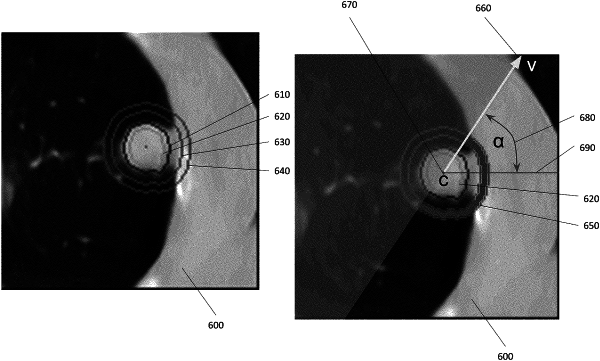| CPC G06T 11/008 (2013.01) [G06T 5/002 (2013.01); G06T 7/73 (2017.01); G06T 11/006 (2013.01); G06T 2207/10064 (2013.01); G06T 2207/10081 (2013.01); G06T 2207/20081 (2013.01); G06T 2207/30061 (2013.01); G06T 2207/30096 (2013.01); G06T 2207/30204 (2013.01); G06T 2210/41 (2013.01); G06T 2211/421 (2013.01)] | 6 Claims |

|
1. A method, comprising:
obtaining, by a controller unit, a plurality of fluoroscopic images of a region of interest of tissue of a patient,
wherein each image of the plurality of fluoroscopic images is obtained by a C-arm device with the C-arm device positioned at a particular pose of a plurality of poses traversed by the C-arm device while the C-arm device is moved through a range of rotation, and
wherein the range of rotation encompasses less than 180 degrees of rotation;
reconstructing, by the controller unit, using the plurality of fluoroscopic images, a tomographic image including the region of interest; and
enhancing, by the controller unit, the tomographic image using a trained tomographic image enhancement machine learning model to generate an enhanced tomographic image,
wherein the trained tomographic image enhancement machine learning model has been trained by a training process comprising:
receiving CT image data for a plurality of patients,
wherein the CT image data comprises a ground truth tomographic image for each of the plurality of patients;
receiving a plurality of fluoroscopic images for each of the plurality of patients,
generating, based on the CT image data for each of the plurality of patients, a plurality of simulated fluoroscopic images,
wherein each fluoroscopic image of the plurality of simulated fluoroscopic images corresponds to a particular pose of a C-arm device at a particular angle, and
wherein the plurality of fluoroscopic images corresponds to a plurality of angles that spans a range of rotation that is between 45 degrees and 120 degrees;
reconstructing, based on the plurality of fluoroscopic images for each of the plurality of patients, a simulated tomographic image for each of the plurality of patients, wherein the simulated tomographic image comprises a plurality of artifacts;
utilizing a tomographic image enhancement machine learning model to perform an enhancement process to enhance the simulated tomographic image for each of the plurality of patients to reduce the plurality of artifacts, to obtain an enhanced simulated tomographic image for each of the plurality of patients;
scoring each enhanced simulated tomographic image based on the plurality of artifacts and a corresponding ground truth tomographic image to obtain a corresponding performance score for the tomographic image enhancement machine learning model;
updating parameters of the tomographic image machine learning model while the performance score for the tomographic image enhancement machine learning model is less than a predetermined performance score threshold; and
iteratively repeating the enhancement process until the corresponding performance score is equal to or above the predetermined performance score threshold to result in the trained tomographic image enhancement machine learning model.
|